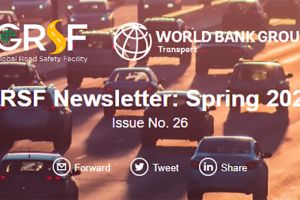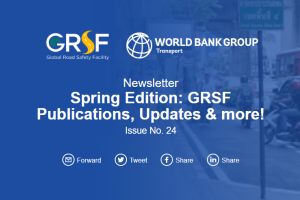Special Edition: GRSF Annual Report, Updates & More!
March 24, 2022

GRSF Annual Report ⌵︎

Global Road Safety Facility (GRSF) is pleased to present our Annual Report 2021. GRSF's work in improving road safety outcomes through technical assistance, grant-funded activities, and direct delivery of road safety interventions has now expanded to 84 countries. Find out about our interventions, impact, research, and more in the Annual Report.

Event Highlights ⌵︎
 On February 23rd, the Global Road Safety Facility (GRSF) and the International Transport Forum (ITF) organized the launch of the Guidelines for Conducting Road Safety Data Reviews. A diverse group of speakers presented on the various aspects of the whole data collection process, such as road crash investigation, reporting, and registration, checking completeness and consistency, storage, and accessibility - as well as analysis and use.
On February 23rd, the Global Road Safety Facility (GRSF) and the International Transport Forum (ITF) organized the launch of the Guidelines for Conducting Road Safety Data Reviews. A diverse group of speakers presented on the various aspects of the whole data collection process, such as road crash investigation, reporting, and registration, checking completeness and consistency, storage, and accessibility - as well as analysis and use.
GRSF’S Knowledge Booth at Transforming Transportation 2022 📣
During Transforming Transportation 2022 (February 16-17), GRSF presented a set of presentations and live discussions as part of the Expo’s Knowledge Booths. GRSF’s booth provided the attendants with the opportunity to learn more about evidence-based knowledge to address the road safety crisis. During the first day, the focus of the session was on road safety data, with a series of technical presentations and discussions, including a demonstration of the updated road safety toolkit, financed under BIGRS. The second day was about speed management, showcasing the GRSF Speed Management Hub, outcomes of the Active Transport Mobility and Safety under BIGRS, but also technical discussions on developing speed management strategies and action plans.
Webinar series on Safer Road Infrastructure in the Asia-Pacific 🚧

During February 8-24, the World Bank GRSF and the Asian Development Bank led the delivery of the webinar series Helping Save Lives from Road Crashes in Asia-Pacific under the Bloomberg Philanthropies Initiative for Global Road Safety 2020-2025 and the Road Safety Capacity Building Programme for Asia and the Pacific.
This online learning event was focused on safer road infrastructure recommendations from the Global Plan for the Decade of Action for Road Safety 2021-2030, by sharing knowledge, tools, and case studies from the region to help countries identify and eliminate high-risk roads, unlock the economic benefits of 3-star or better roads, and meet the global Sustainable Development Goals and United Nations Target obligations. This webinar series had over 1,000 participants coming from 56 countries.
Research Highlights ⌵︎
 The Korea Transport Institute (KOTI) and the World Bank conducted a joint research project to assess the safety benefit of lowered speed limits on urban roads and to inform future policy development on speed limits in urban areas. Specifically, this study analyzes how changes in the speed limit affect safety performance and operational performance. Because speed limits influence the operating speed of the facility and affect both safety and operational efficiencies, the study team hypothesized that studying the effect of changes in speed limit might yield valuable demonstration examples in the context of Asia and other developing countries.
The Korea Transport Institute (KOTI) and the World Bank conducted a joint research project to assess the safety benefit of lowered speed limits on urban roads and to inform future policy development on speed limits in urban areas. Specifically, this study analyzes how changes in the speed limit affect safety performance and operational performance. Because speed limits influence the operating speed of the facility and affect both safety and operational efficiencies, the study team hypothesized that studying the effect of changes in speed limit might yield valuable demonstration examples in the context of Asia and other developing countries.
 Road traffic crashes can cost countries as much as 6 percent of their GDP and trap families in poverty as they lose income-generating potential and focus on providing lifetime care. This report examines the potential for private capital mobilization to close this gap. The report, funded by IFC, the Global Road Safety Facility (GRSF), and the Public-Private Investment Advisory Facility (PPIAF), investigates the market failure to appropriately account for the cost of road crashes, which prevents private capital from flowing to road safety investments. The growth of socially responsible investing and the sustainable finance market offers a new opportunity to address this market failure. The report proposes different business models and financing instruments to channel private investment into road safety projects. The report also examines the enabling environment for structuring investable road safety projects in a sample of countries.
Road traffic crashes can cost countries as much as 6 percent of their GDP and trap families in poverty as they lose income-generating potential and focus on providing lifetime care. This report examines the potential for private capital mobilization to close this gap. The report, funded by IFC, the Global Road Safety Facility (GRSF), and the Public-Private Investment Advisory Facility (PPIAF), investigates the market failure to appropriately account for the cost of road crashes, which prevents private capital from flowing to road safety investments. The growth of socially responsible investing and the sustainable finance market offers a new opportunity to address this market failure. The report proposes different business models and financing instruments to channel private investment into road safety projects. The report also examines the enabling environment for structuring investable road safety projects in a sample of countries.
Speed management is one of the most effective ways to bring about improvements in road safety and has other potential co-benefits, including decarbonization and broader health impacts. Through the Grant Program fund by UK Aid and under the Bloomberg Philanthropies Initiative for Global Road Safety, four new research projects on speed management were kicked-off in January 2022:
- "Assessment of 30 km/h urban speed zones and factors contributing to local modification for lower speed in Cameroon, Kenya, and Rwanda" with the Global Alliance of NGOs for Road Safety
- "Research project to determine the scalability and efficacy of a Speed Management and Assessment Tool (SMAT) to multiple LMICs utilizing existing data for in Nepal, Fiji and Ghana" with TRL Limited
- "Research on the Impacts of Automated Speed Enforcement (ASE) in Rwanda to Develop a Guide for African countries" with Traffic Injury Research Foundation
- “Research analysis on the economics and benefits of speed management” with Steer Group
Partnerships to Save Lives ⌵︎
IWD 2022 Break the Bias Blog – Star Ratings and Gender Analysis
 Monica Olyslagers, iRAP’s Global Innovation Manager, writes on gender inequity in transport as one of the key challenges to ensuring a safer and more equitable future for our children. This recently-published blog looked at a sample of cities that completed iRAP assessments with the support of the World Bank Global Road Safety Facility as part of the Bloomberg Philanthropies Initiative for Global Road Safety between 2015 and 2019, and where data for travel by mode and gender was available. The results show a fascinating story. It shows clearly that our road and street networks are, on the whole, less safe for women than for men.
Monica Olyslagers, iRAP’s Global Innovation Manager, writes on gender inequity in transport as one of the key challenges to ensuring a safer and more equitable future for our children. This recently-published blog looked at a sample of cities that completed iRAP assessments with the support of the World Bank Global Road Safety Facility as part of the Bloomberg Philanthropies Initiative for Global Road Safety between 2015 and 2019, and where data for travel by mode and gender was available. The results show a fascinating story. It shows clearly that our road and street networks are, on the whole, less safe for women than for men.
The blog highlights that knowing how and where women travel is the first step to making changes. We need more data, disaggregated by gender and mode, and systematic participation of communities in road planning and design.
Data-driven Policymaking can Save Lives and Reduce Road Trauma in Eastern Partnership: The Eastern Partnership Road Safety Observatory
Fatality rates in the Eastern Partnership (EaP) countries (Armenia, Azerbaijan, Georgia, Moldova, and Ukraine) are still about twice as high as in the European Union (EU27) area, triggering high socio-economic costs, estimated at 2.6% of the region’s GDP. Policymakers rely heavily on accurate data to set objectives, act, and measure progress. Still, data discrepancy in the EaP region reported at the national level and corrected by WHO has been estimated at between 14 to 22% in 2009-2019. This shows a high level of underreporting in the region presumably due to a lack of robust data collection systems that are interlinked with hospitals, police, and other actors within the countries.
From crisis to opportunity: How the Philippines built 500km of bike lanes in less than a year

In September 2020, the rise of cycling led the national government to allocate more than 22 Million USD for active mobility infrastructure. This translated into the largest bike lane construction program in the country’s history: almost 500 kilometers across Metro Manila, Metro Cebu, and Metro Davao.
Designing, adapting, and building hundreds of kilometers of infrastructure for active transport in less than a year is no easy task. To support this initiative, the World Bank Philippines Transport Team, with funding support under BIGRS and the Australian government, joined forces to provide technical assistance from the very beginning, with a focus on ensuring the new cycling infrastructure could meet the highest safety standards.
FIND FAQs in the GRSF Speed Management Hub!
Visit GRSF's online platform that allows the wide dissemination of frequently asked questions (FAQ) on speed management, together with a comprehensive resource library and the latest news and examples of best practices on this topic.
Read more
To stay up to date with GRSF's latest news and events, please subscribe to our newsletters clicking the link below.


